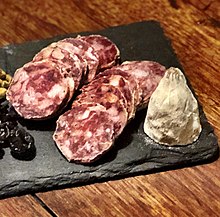Cacciatore
Cacciatore (/ˌkɑːtʃəˈtɔːri/, /ˌkætʃ-/;[1] Italian pronunciation: [kattʃaˈtoːre]) means "hunter" in Italian. In cuisine, alla cacciatora refers to a meal prepared "hunter-style"[clarification needed] with onions, herbs, usually tomatoes, often bell peppers, and sometimes wine.
Cacciatore is popularly made with braised chicken[2] (pollo alla cacciatora) or rabbit[3] (coniglio alla cacciatora). The salamino cacciatore is a small salami that is seasoned with only garlic and pepper.[4]
Preparation
Chicken cacciatora
Chicken cacciatore typically, but not always, includes base ingredients of onion, garlic, and tomato.[5]
Salami cacciatore

Salami Cacciatore typically originates from the southern Italian Provinces of Calabria, specifically Squillace. Ingredients vary from region to region.
Variations
The many different variations of this dish are based upon ingredients available in specific regions. For example, in southern Italy, cacciatore often includes red wine, while northern Italian chefs might use white wine. Some versions of the dish may use mushrooms.[5]
See also
References
- ^ Collins English Dictionary – Complete and Unabridged, 12th Edition 2014. S.v. "Cacciatore." Retrieved November 13, 2018, from https://www.thefreedictionary.com/cacciatore
- ^ Halvorsen, Francine (2007). Crowd-Pleasing Potluck. Rodale. p. 90. ISBN 978-1594864742.
- ^ Buonopane, Marguerite DiMino (2012). The North End Italian Cookbook, 6th. Globe Pequot. p. 367. ISBN 978-0762781904.
- ^ DK Publishing (contributor) (2012). Sausage. Penguin. p. 60. ISBN 978-1465400925.
{{cite book}}:|author=has generic name (help) - ^ a b Schroeder, Lisa (2009). Mother's Best: Comfort Food That Takes You Home Again. Taunton Press. pp. 119–121. ISBN 978-1600850172.


